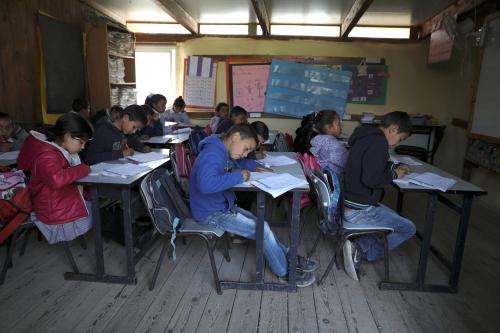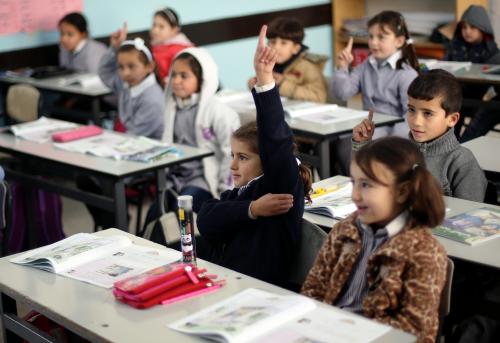This blog is a summary of the Mexico pilot study of the Breadth of Learning Opportunities toolkit, which is available here.
Despite all the international efforts to measure and improve children’s knowledge in mathematics, language, and science, a growing body of evidence has repeatedly shown that these subjects are no longer sufficient to thrive in work and life. A broader range of skills such as collaboration, problem solving, critical thinking, and creativity are necessary to meet societal the demands of the 21st century. This means we need to evaluate and understand the opportunities in the education system for students to develop a broader range of skills. This is more crucial in less developed countries, where the distribution of learning opportunities is highly unequal.
The first step toward more comprehensive learning process starts with dialogue both within and across the different levels of the education system. In this regard, the Center for Universal Education (CUE) at Brookings and Education International (EI) developed the Breadth of Learning Opportunities (BOLO) toolkit, which centers on a set of questionnaires administered to policymakers, school administrators, and teachers. The three tools—policy, school, and teacher tools—aim to provide information on the inputs and processes behind the opportunities children have to learn a broad range of skills. They also help users identify restrictions to breadth of learning opportunities, such as high-stakes assessments focusing only on literacy, numeracy, and science, or narrowly defined subject areas.
In Mexico, a BOLO pilot study was conducted by a research team at El Centro de Cooperación Regional para la Educación de Adultos en América Latina y El Caribe (CREFAL) to determine the degree of alignment between the three tools and to obtain feedback on the usefulness of the collected data. More details on the pilot, carried out from May-August 2017, can be found in the BOLO Technical Report. Nevertheless, there were some challenges, insights, and lessons learned that might be useful for other researchers to consider when implementing the tools.
First, usage of the BOLO tools requires a careful account of the variety of country, regional, and education system contexts. Mexico’s education system is decentralized. There is a national curriculum set by the federal Secretariat of Public Education (SEP), but each state has flexibility in terms of how it chooses to implement it, which made regional differences important to consider during the pilot study. Also, the influence of teachers’ unions strongly varies from state to state. The pilot tools were applied in three States (Oaxaca, Michoacán, and Aguascalientes), which were chosen in order to display, as much as possible, the diversity of institutions, student performance, and socioeconomic context in the country. For example, Aguascalientes has had the highest economic growth during the last six years; 35 percent of its students are graded as “good or excellent,” and the teachers union is not especially strong. In contrast, Oaxaca, located in the south, has the second to the last economy in the country and students have consistently performed among the lowest in national standardized tests—only 8.8 percent are graded as “good or excellent.” In addition, the teachers union there is highly influential, and the most recent reforms in teacher evaluation, professional development, and curriculum have not been implemented in this state.
Second, different stakeholders can be barriers or facilitators, depending on their role and context. CREFAL’s research team experienced some challenges in accessing schools and teachers. For instance, despite the state authorities’ effort, access to schools in Oaxaca was constrained due to teachers unions, connectivity, and time constraints. However, this southern state was central to understanding how the tools operated in a context of higher poverty and lower educational performance. Thus, CREFAL’s team used informal networks to contact teachers and principals to interview them outside of the schools. On the other hand, local authorities were open and responsive to the policy instrument in all three states. There was also no need to seek out extensive access to the federal education authorities at the SEP, which allowed the coordinator more flexibility in administering the tools so they could reflect on the breadth of learning opportunities. Local authorities also facilitated a list of primary and secondary schools to visit that could also represent a variety of contexts within states in both rural and urban areas.
Undoubtedly, in the case of Mexico, the most informative part of the project was when authorities, principals, and teachers gave their thoughts after being presented with the collected data. For the CREFAL team, it was broadly rewarding to observe these educational actors openly reflecting on the results, while formulating hypotheses on the possible misalignments of the education system, presenting in-depth perspectives regarding challenges and recommendations, and suggesting the contributing factors to limited opportunities for learning across a broader range of skills. From this experience, it can be largely suggested that the BOLO tools have the potential to set a more informed dialogue within and across the different levels of the education system, as a first step towards delivering the breadth of learning opportunities students require.
The Brookings Institution is committed to quality, independence, and impact.
We are supported by a diverse array of funders. In line with our values and policies, each Brookings publication represents the sole views of its author(s).






Commentary
Aligning policymakers, schools, and teachers: Lessons from Mexico
June 12, 2018